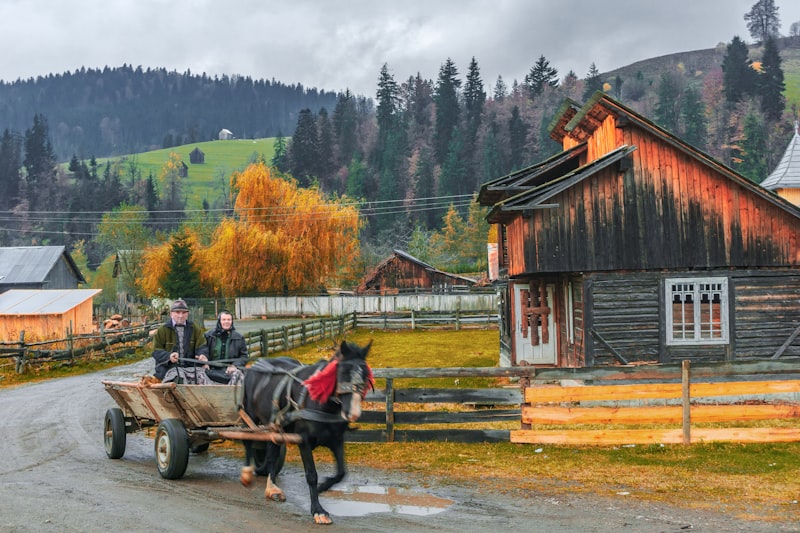Imagine stepping into a world where ancient legends come alive, where every rustle of leaves or distant howl carries a whisper of supernatural dread. This is the world crafted by modern horror writers who draw inspiration from folklore. They harness the power of age-old myths and legends to evoke primal fears and suspense, tapping into the universal human psyche.
Take, for example, the ubiquitous vampire. This iconic figure of horror finds its origins in various folklore traditions around the world, from the European tales of blood-sucking revenants to the Southeast Asian legends of vampiric entities. By adapting these folklore elements, modern storytellers have transformed the vampire into a timeless symbol of seduction and terror, immortalized in countless novels, films, and television series.
Likewise, the chilling concept of the haunted house owes its existence to centuries-old ghost stories and supernatural folklore. These tales of restless spirits and malevolent entities have evolved into cornerstone motifs of horror fiction, captivating audiences with their eerie atmospheres and lingering sense of dread.

The allure of folklore lies not only in its ability to evoke fear but also in its cultural resonance. By integrating folklore into modern horror stories, writers imbue their narratives with a sense of authenticity and depth. Readers and viewers, familiar with these age-old legends, find themselves drawn deeper into the dark realms of imagination, where the boundaries between reality and the supernatural blur.
The influence of folklore on modern horror stories is undeniable. It provides a rich tapestry of myths, legends, and superstitions that enrich contemporary narratives with a sense of history and mystery. As storytellers continue to explore the depths of human fear, folklore remains a potent source of inspiration, ensuring that the legacy of ancient terrors endures in the terrifying tales of today and tomorrow.
From Myth to Modern Fear: How Folklore Shapes Today’s Horror Narratives

Have you ever wondered how ancient tales of monsters and spirits still haunt our modern-day nightmares? The answer lies in the eerie power of folklore, weaving its way through generations to inspire the chilling tales that keep us on edge today.
Folklore, with its roots deep in cultural beliefs and oral traditions, serves as a rich tapestry for horror storytellers. These age-old myths and legends, passed down through centuries, carry with them a primal essence that taps into our deepest fears. Whether it’s the malevolent spirit of a vengeful ghost or the sinister allure of a shape-shifting creature, these tales resonate because they speak to universal human anxieties.
Take, for instance, the ubiquitous presence of vampires in literature and cinema. Originating from Eastern European folklore, these undead beings have evolved from bloodthirsty monsters into complex characters grappling with immortality and desire. The transformation of folklore figures like vampires into cultural icons demonstrates their enduring relevance in exploring themes of mortality and temptation.
Similarly, ghost stories draw upon the haunting specters that populate legends worldwide. From the vengeful spirits of Japanese folklore to the restless souls of Victorian England, these tales exploit our fear of the unknown and the unresolved. They remind us that the past, with its mysteries and tragedies, often refuses to stay buried.
In today’s digital age, folklore continues to inspire new avenues of horror storytelling. Creators blend ancient myths with contemporary anxieties, crafting narratives that reflect our evolving fears of technology, isolation, and environmental collapse. The result is a genre that constantly reinvents itself while remaining tethered to the timeless dread seeded by folklore.
As we navigate the shadows between myth and modernity, one thing remains clear: the power of folklore to terrify and captivate endures, shaping the spine-chilling narratives that haunt our collective imagination.
Unveiling the Haunting Origins: Folklore’s Role in Contemporary Horror
Folklore, with its rich tapestry of myths and legends passed down through generations, plays a pivotal role in shaping contemporary horror narratives. These tales, steeped in the eerie and the unknown, serve as a wellspring of inspiration for modern storytellers seeking to evoke fear and fascination in their audiences.
At the heart of folklore’s allure lies its ability to tap into primal fears and universal themes. Stories of vengeful spirits, malevolent creatures lurking in the shadows, and cursed objects resonate across cultures, transcending time and geography. They provide a cultural repository of the macabre, offering endless possibilities for reinterpretation in today’s horror literature, film, and art.
In contemporary horror, folklore serves not merely as a backdrop but as a dynamic force driving narrative tension and character development. It infuses stories with a sense of authenticity and rootedness, grounding supernatural elements in a familiar, albeit unsettling, context. By drawing on folklore, storytellers can imbue their creations with a haunting realism that resonates deeply with audiences, blurring the lines between the imagined and the tangible.
Moreover, folklore’s enduring appeal lies in its capacity to evolve with societal anxieties and technological advancements. Tales once whispered around campfires now find new life in digital formats, adapting to the ever-changing landscape of horror entertainment. This evolution underscores folklore’s timeless relevance, proving its ability to adapt while retaining its core ability to terrify and captivate.

Folklore continues to serve as a cornerstone of contemporary horror, offering storytellers a treasure trove of chilling motifs and cautionary tales. By exploring the haunting origins embedded within these age-old narratives, creators can tap into a primal source of fear that transcends cultural boundaries and resonates across generations.
Ghostly Echoes: Folklore Legends that Inspired Iconic Horror Characters
Have you ever wondered about the chilling origins behind some of our favorite horror characters? Dive into the eerie world of folklore legends that have inspired iconic figures in horror literature and cinema. These tales, steeped in centuries-old myths and superstitions, continue to haunt our imaginations to this day.
One of the most iconic figures in horror, the vampire, finds its roots in various folklore traditions worldwide. From the Slavic legends of the strigoi to the Romanian tales of Vlad the Impaler, these blood-drinking creatures of the night have fascinated and terrified for generations. Their ability to transform into bats and their aversion to sunlight echo fears deeply ingrained in ancient cultures.
Moving from Eastern Europe to the misty moors of England, we encounter another timeless legend—the werewolf. Often linked to the full moon and the untamed wilderness, the werewolf embodies our primal fears of losing control and giving in to animalistic instincts. Stories of men turning into wolves under the pale light of the moon have been told across cultures, from European folklore to Native American traditions.
But it’s not just creatures of the night that populate our nightmares. The ghostly apparitions that haunt abandoned houses and ancient castles stem from ghost stories passed down through generations. These spirits, trapped between worlds, serve as cautionary tales or reminders of unfinished business, their presence evoking a spine-chilling sense of dread.
Imagine the shiver-inducing tales of vengeful spirits seeking retribution or lost souls forever wandering the halls of their former residences. These stories, whether whispered around a campfire or recounted in Gothic literature, tap into our deepest fears of the unknown and the supernatural.
The folklore legends that inspired iconic horror characters continue to captivate audiences worldwide. From vampires to werewolves and ghosts, these age-old tales remind us of the power of storytelling to evoke fear and fascination. So, the next time you hear a creak in an empty hallway or catch a glimpse of a shadowy figure in the corner of your eye, remember—the echoes of folklore are never far behind.
The Dark Roots of Modern Terror: Folklore’s Impact on Horror Cinema
Folklore, with its rich tapestry of myths, legends, and supernatural entities, provides a treasure trove of inspiration for filmmakers. From vengeful spirits haunting abandoned buildings to shape-shifting creatures prowling in the night, folklore offers a vast array of terrifying possibilities. These tales, passed down through generations, tap into our primal fears and superstitions, making them perfect fodder for spine-chilling narratives on the silver screen.

Consider how folklore transforms ordinary settings into realms of terror. A quaint village becomes the breeding ground for a malevolent entity that preys on unsuspecting travelers. An innocuous-looking doll becomes the vessel for a vengeful spirit seeking retribution. These narratives, rooted in folklore, capitalize on our fear of the unknown and the supernatural, heightening suspense and ensuring a lasting impact on viewers.
Moreover, folklore adds a layer of authenticity to horror cinema. By grounding stories in cultural myths and beliefs, filmmakers create a sense of familiarity that resonates deeply with audiences worldwide. Whether it’s the restless spirits of Japanese folklore or the malevolent creatures of European legends, these tales bridge cultural divides and evoke universal fears.
In essence, folklore is the dark undercurrent that flows beneath the surface of modern horror cinema. It shapes narratives, instills primal fear, and connects viewers to a collective subconscious haunted by ancient terrors. As filmmakers continue to delve into the depths of folklore, one thing remains certain: the chilling tales of old will continue to cast their shadow on the silver screen, captivating and terrifying audiences for generations to come.
Bloodcurdling Tales: Folklore Themes in Bestselling Horror Literature
Horror literature has long been a captivating realm where the echoes of ancient folklore resonate, stirring primal fears within readers. From the chilling depths of folklore emerge timeless themes that authors deftly weave into their narratives, creating spine-tingling tales that haunt our imagination.
One of the most intriguing aspects of bestselling horror literature is its deep-rooted connection to folklore. These tales draw upon age-old legends, superstitions, and mythical creatures that have permeated cultures across centuries. Authors harness these elements to infuse their stories with an eerie familiarity, tapping into universal fears and superstitions that transcend time and geography.
Take vampires, for example. These immortal creatures of the night have been part of folklore from Eastern Europe to Asia, each culture adding its own twist to the legend. In horror literature, vampires embody both allure and terror, exploring themes of eternal life, forbidden desires, and the darkness that resides within us all.
Werewolves, another staple of folklore, evoke primal fears of transformation and uncontrollable impulses. In literature, they symbolize the struggle between humanity and bestial instincts, often set against moonlit landscapes and isolated villages where ancient curses reign.
Ghosts, spirits, and other supernatural entities populate horror literature, drawing from a rich tapestry of ghost stories and hauntings found in folklore worldwide. These spectral beings embody unresolved traumas, unfinished business, or the eerie consequences of disturbing the natural order.
Witches and sorcery, too, find their place in bestselling horror literature, conjuring images of arcane rituals, cursed objects, and deals with otherworldly entities. These tales explore the boundaries of power and morality, often blurring the line between good and evil.
Ultimately, what makes folklore themes so compelling in horror literature is their ability to evoke deep-seated fears and provoke contemplation on the unknown. By intertwining ancient myths with modern storytelling techniques, authors create narratives that not only terrify but also resonate with readers on a primal level.
Frequently Asked Questions
How does folklore contribute to the atmosphere and setting in contemporary horror fiction?
Folklore enriches contemporary horror fiction by infusing authentic cultural elements into the atmosphere and setting. It adds depth through eerie traditions, mythical creatures, and supernatural beliefs, creating a chilling backdrop that resonates with readers through familiar yet unsettling narratives.
What are some examples of folklore elements commonly used in modern horror stories?
Explore how folklore elements like haunted places, supernatural creatures, and cursed objects inspire modern horror stories. Discover how ancient myths and legends continue to shape chilling tales in contemporary literature and cinema.
How can understanding folklore enhance our appreciation of modern horror literature and films?
Understanding folklore enriches our appreciation of modern horror literature and films by revealing recurring themes, archetypes, and cultural fears that shape narratives. It provides context for supernatural elements and character motivations, fostering deeper connections and insights into the origins of horror tropes.
What cultural significance do folkloric themes bring to modern horror storytelling?
Folkloric themes in modern horror storytelling provide rich cultural significance by tapping into primal fears and universal motifs. They add depth and authenticity to narratives, connecting contemporary audiences to ancient traditions and exploring the darker aspects of human experience through familiar folklore elements.
Why do modern writers often incorporate folktales into their horror narratives?
Discover why modern writers frequently weave folktales into their horror narratives, exploring how these timeless stories enrich and deepen the chilling atmosphere, evoking primal fears and cultural echoes that resonate with contemporary audiences.



